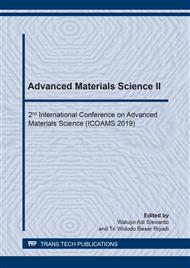[1]
K.Y. Ann, H.Y. Moon, Y.B. Kim, J. Ryou, Durability of recycled aggregate concrete using pozzolanic materials, Waste Management 28(6) (2008) 993-999.
DOI: 10.1016/j.wasman.2007.03.003
Google Scholar
[2]
M. Gomes, J. de Brito, Structural concrete with incorporation of coarse recycled concrete and ceramic aggregates: durability performance, Materials and Structures 42(5) (2009) 663-675.
DOI: 10.1617/s11527-008-9411-9
Google Scholar
[3]
G. De Schutter, K. Audenaert, Evaluation of water absorption of concrete as a measure for resistance against carbonation and chloride migration, Materials and Structures/Materiaux et Constructions 37(273) (2004) 591-596.
DOI: 10.1617/14045
Google Scholar
[4]
L. Evangelista, J. de Brito, Durability performance of concrete made with fine recycled concrete aggregates, Cement and Concrete Composites 32(1) (2010) 9-14.
DOI: 10.1016/j.cemconcomp.2009.09.005
Google Scholar
[5]
S.C. Kou, C.S. Poon, Properties of concrete prepared with PVA-impregnated recycled concrete aggregates, Cement and Concrete Composites 32(8) (2010) 649-654.
DOI: 10.1016/j.cemconcomp.2010.05.003
Google Scholar
[6]
G.F. Peng, Q.B. Liu, Z.B. Guo, Q.X. Hou, S.Q. Cao, J.F. Zhang, Mechanical Properties and Permeability of Recycled Aggregate Concrete at Low Water/Binder Ratio, Key Engineering Materials 477 (2011) 16-22.
DOI: 10.4028/www.scientific.net/kem.477.16
Google Scholar
[7]
Y.A. Villagran-Zaccardi, C.J. Zega, A.A.D. Maio, Chloride Penetration and Binding in Recycled Concrete, Journal of Materials in Civil Engineering 20(6) (2008) 449-455.
DOI: 10.1061/(asce)0899-1561(2008)20:6(449)
Google Scholar
[8]
S.C. Kou, C.S. Poon, D. Chan, Influence of Fly Ash as Cement Replacement on the Properties of Recycled Aggregate Concrete, Journal of Materials in Civil Engineering 19(9) (2007) 709-717.
DOI: 10.1061/(asce)0899-1561(2007)19:9(709)
Google Scholar
[9]
S. Ismail, M. Ramli, Mechanical strength and drying shrinkage properties of concrete containing treated coarse recycled concrete aggregates, Construction and Building Materials 68(0) (2014) 726-739.
DOI: 10.1016/j.conbuildmat.2014.06.058
Google Scholar
[10]
S. Ismail, M. Ramli, Effects of adding fibre on strength and permeability of recycled aggregate concrete containing treated coarse RCA, International Journal of Civil, Architectural, Structural and Construction Engineering 8(8) (2014) 890-896.
Google Scholar
[11]
BS 1881-124, Testing concrete Part 124: Methods for analysis of hardened concrete, British Standards Institution London (1988).
Google Scholar
[12]
BS 8110-1, Structural use of concrete, Part 1: Code of practice for design and construction, British Standards Institution, London, (1997).
Google Scholar
[13]
ACI Committee 222R-01, Protection of metals in concrete against corrosion., American Concrete Institute, Farmington Hills Michigan, (2001).
Google Scholar
[14]
A.A. Ramezanianpour, M. Esmaeili, S.A. Ghahari, M.H. Najafi, Laboratory study on the effect of polypropylene fiber on durability, and physical and mechanical characteristic of concrete for application in sleepers, Construction and Building Materials 44(0) (2013) 411-418.
DOI: 10.1016/j.conbuildmat.2013.02.076
Google Scholar
[15]
M. Ramli, W.H. Kwan, N.F. Abas, Application of non-corrosive barchip fibres for high strength concrete enhancements in aggressive environments, Composites Part B: Engineering 53(0) (2013) 134-144.
DOI: 10.1016/j.compositesb.2013.04.012
Google Scholar
[16]
BS 6349-1, Maritime structures. General criteria, British Standards Institution, London (1984).
Google Scholar


